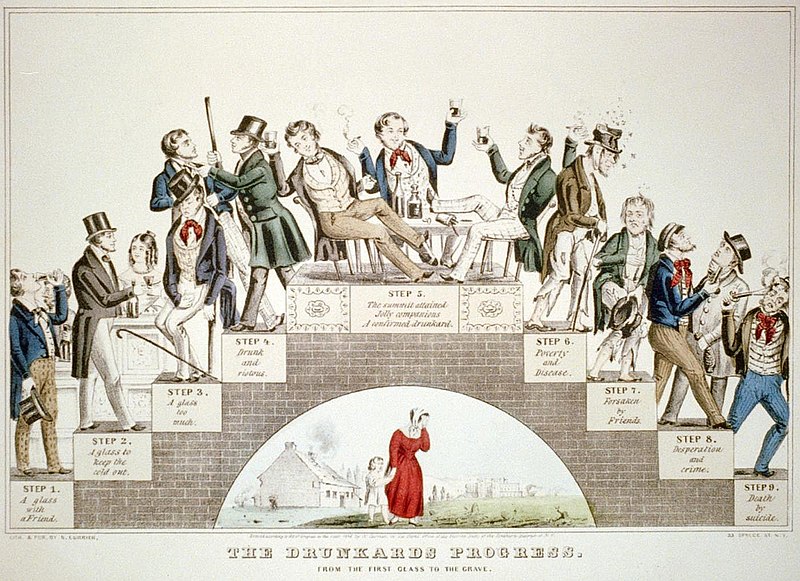|

February 3, 2020
#307
Exactly seven years ago, February 4, 2013, we
began posting Barbara Schock's Sandburg Hometown series on our Carl Sandburg
Historic Site Association website. This week's post is #307!! Thank you,
Barbara, for sharing your extraordinary gift of these vignettes of Galesburg &
19th century American history.

The Drunkards Progress
From the First Glass to the Grave
The Drunkard's Progress (1846) by Nathaniel
Currier warns that moderate drinking leads to total
disaster step-by-step
|
The Temperance Movement By Barbara
Schock
When Carl Sandburg was in eighth grade he learned
about the physiology of the human body. There were drawings in his school
textbook which illustrated the effects of alcohol on the human body.
In his autobiography, Always the Young Strangers,
Sandburg described the drunkard’s stomach. “The color turns from pink and clean
to a rotten radish red with blobs of stinking black and purple and a few rust
spots.” He and his friends walked along Prairie Street, Boone’s Alley and the
Public Square and the smell of the saloons was enough to tell them alcohol was
“eating away at stomach linings like rats in a corn crib.”
In the 1830s when the idea of a colony in the West came
to the Reverend G.W. Gale, the average American drank nearly seven gallons of
pure alcohol in a year. The covenant of the settlement expressly forbade the
possession and consumption of alcohol.
Because of the social problems of poverty associated with
drinking, the temperance movement was begun by religious groups, especially
women. They had few legal rights and were totally dependent on their husbands.
Their children were deprived of sufficient food and a healthy environment. The
children often had to leave school and go to work to help support the family.
Even though Carl Sandburg’s father didn’t drink to
excess, his wages from the railroad blacksmith shop were barely enough to
support the family. The Robber Barons of the times paid low wages in order to
fill their own pockets.
The temperance movement also began in the 1830s. The men
and women involved were concerned with the moral fiber of society. Methodist and
Baptist clergymen began to organize and protest for temperance.
The Women’s Temperance Union was organized December 23,
1873, in Hillsboro, Ohio. The stated purpose of the organization was to create a
sober and pure world by abstinence, purity and evangelical Christianity. The
members felt alcohol was a cause and consequence of larger social problems
rather than a personal weakness.
The movement spread across the country and around the
world. By 1890 the W.C.T.U. was the largest women’s organization in the world.
The ease of railroad travel helped the W.C.T.U. spread its message from coast to
coast in the United States. Galesburg had a chapter which continued into the
mid-twentieth century.
The W.C.T.U. was also interested in other social reform
issues. They focused on elimination of prostitution, sanitation and women’s
suffrage. They held classes to help immigrants learn English and the customs of
the American people.
A Galesburg resident, Mary Allen West, became a leader in
the organization and traveled as far as Japan to spread the message of
temperance. Unfortunately, she died there and her body was returned to Galesburg
for burial.
|
